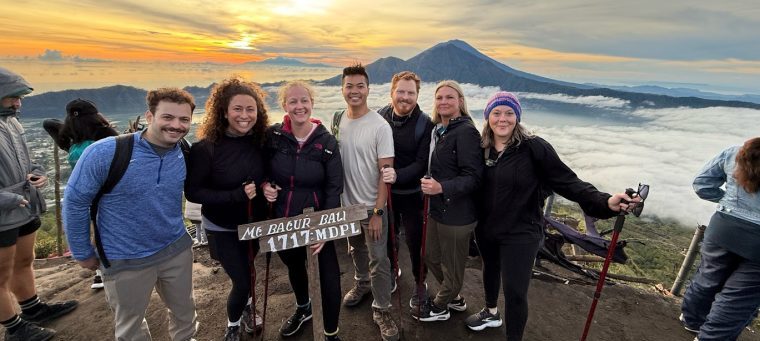Bali. The word conjures images: some romantic, some reductive. To many Australians, it’s the ultimate budget getaway; a place of Bintangs and beach bars. For others, it’s a place of yoga retreats and “Eat Pray Love” pilgrimages.
But as I discovered during a 9-day Intrepid adventure across this Indonesian island, Bali is much more than either stereotype.
It’s a place where volcanic peaks brush the sky, where culture is lived not performed and where local communities are actively shaping a more sustainable future.
My journey began after a quick flight from Singapore to get in a few days before the tour ticked off in Ubud, often described as Bali’s spiritual heart. While it’s no longer the untouched village it once was, Ubud still pulses with tradition albeit alongside Bondi-inspired cafes and açai bars. Outside town, walking through the rice paddies, we met local farmers who spoke about the Subak system, an ancient, community-based irrigation method recognised by UNESCO. It’s the kind of quiet genius that doesn’t scream for attention but earns your respect.
That same day, we were welcomed into a family compound, where we shared kopi Bali and fritters while learning about daily temple offerings and Balinese Hinduism.
The Intrepid trip took us to Undisan, where the buzz of scooters gave way to the gentle hush of forests and birdsong. In these less-touristy areas, we met wood carvers and sarong weavers. These weren’t “tourist stops” but learning about the importance of these living traditions.
In Sibetan, we stayed with a local family in a homestay framed by salak plantations. We picked the snake fruit ourselves and talked to our hosts about changing weather patterns and how they’re affecting local agriculture. Every meal was home-cooked, spicy and served with the kind of hospitality that makes you forget you’re technically a guest.
Of course, no visit to Bali is complete without a little adventure and Mt Batur delivered that and more. We set off at 2:30 AM by torchlight, the rocky trail lit only by the occasional shooting star and our own anticipation. The summit, at 1,717 meters, isn’t Everest but it feels like it when the first light breaks across Lake Batur and the clouds burn pink over neighbouring Mount Agung. Watching the world wake up from the roof of Bali is something I’ll never forget.
We later made our way to the northwest coast, to Bali Barat National Park, home to Menjangan Island and some of the island’s best-preserved coral reefs. What surprised me most wasn’t the marine life, although they were magical, it was the coral nurseries.
Here, local dive centres and conservation groups are working together on reef regeneration projects. Structures resembling underwater Christmas trees are seeded with coral fragments, designed to encourage natural growth. It’s a slow process, but one that’s bringing life back to damaged ecosystems. For every bright reef we swam through, there was the reminder that we are visitors here and caretakers, too.
There’s a narrative that Bali is ruined by tourism. And sure, some areas such as Kuta, and parts of Seminyak feel overwhelmed. But the truth is more complex. Tourism has changed Bali, yes. But it has also given locals economic agency, educational opportunities and platforms to share their culture with the world. The trick, it seems, is choosing the kind of Bali you want to experience.
And here’s where I want to challenge the tired idea of Bali as a “Bogan Haven.” It’s a lazy trope that flattens an entire island to the behaviour of (more than) a few drunken Aussies. Bali is home to world-class biodiversity, deeply rooted spiritual traditions and people who are genuinely passionate about preserving both. It’s a place where temple offerings sit beside solar panels, and where Western travellers could stand to learn a lot about humility, hospitality and harmony with nature.
I didn’t find a “bogan paradise.” I found a layered, living culture doing its best to balance modernity with memory. So here’s my advice: go to Bali but come with curiosity, not just a checklist. Climb the volcano, swim the reefs, eat the sambal so spicy it makes you cry. Talk to the locals. Learn a few words. Look beyond the beach club. Because Bali, if you let it, has more to offer than just a holiday. It can give you a new way to see the world.

Leave a Reply